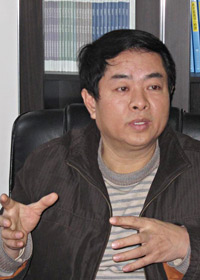|
 |
|
Sheng Yi, head of the Sichuan Academy of Social Sciences' Macroeconomic and Industrial Institute for Economic Research (QIAO TIANBI) |
Less than a month after the 2008's devastating earthquake in Wenchuan, Sichuan Province, the State Council promulgated the Post-Wenchuan Earthquake Restoration and Reconstruction Counterpart Assistance Plan. The plan requested that China's 19 eastern and central provinces and municipalities pair up with the hardest-hit regions. This aid model has been executed smoothly in Sichuan. In late January 2010, Beijing Review reporter Huang Wei interviewed Sheng Yi, head of the Sichuan Academy of Social Sciences' Macroeconomic and Industrial Institute for Economic Research, on how the counterpart assistance mechanism has contributed to restoration, reconstruction and long-term development efforts. Sheng is an expert who has given guidance on planning for post-disaster rebuilding in the province.
Beijing Review: Why did the Central Government decide to use the counterpart assistance mechanism for post-earthquake construction?
Sheng: Counterpart assistance is a resource allocation and regional cooperation mechanism with salient Chinese characteristics. Under this mechanism, developed regions use their fiscal revenue to provide financial support to recipient regions.
This mechanism was not invented after the May 12 Wenchuan Earthquake. In the 1970s and 1980s, there were policies in China that designated economically developed eastern regions such as Shanghai and Jiangsu Province to provide counterpart assistance to Tibet, Xinjiang, Three Gorges Reservoir Area and other poor or extremely poor regions. After the Wenchuan earthquake, various provinces actively gave a helping hand and provided all sorts of assistance to disaster-stricken regions. The Central Government quickly put this voluntary assistance in order, and incorporated the disparate elements into national planning for post-disaster reconstruction.
Beijing Review: What has been the effect of the counterpart assistance mechanism in the reconstruction of the disaster-stricken area?
Sheng: Disaster relief for previous serious disasters primarily took the form of direct fiscal transfers from the Central Government. Introducing the counterpart assistance mechanism into post-disaster restoration and reconstruction is a useful new tool for disaster relief with Chinese characteristics.
Compared with fiscal transfer from the Central Government, counterpart assistance not only gives fund to the earthquake-stricken area, but also provides strong material support, advanced management ideas and highly qualified talents. The areas in Sichuan that were hit worst in the earthquake are relatively closed and economically underdeveloped. The objective behind restoration and reconstruction is not simply to return these areas to their previous level. The Central Government requires that reconstruction should not simply mean giving money to disaster-stricken areas or building houses or roads. Rather, it should gear aid toward constructing an all-around relatively well-off society, promote economic development in disaster-stricken areas and speed up rebuilding the areas into a beautiful homeland.
For more than a year, every province or municipality providing assistance has been highly innovative and creative in the reconstruction of its counterpart disaster-stricken area. They have brought in new ideas and new technologies, guaranteed both funding payments and the timely completion of projects and trained local technology and management talents. In many areas, assistance providers have positively influenced the mindset of local residents.
Beijing Review: What is the advantage of primarily government-administered post-disaster reconstruction?
Sheng: Government-administered post-disaster reconstruction can mobilize broad social support, invest very large amounts of resources in a short time, swiftly restore production and daily life in disaster-stricken areas and enable victims in disaster-stricken areas to rise up from the ruins as quickly as possible. Compared with a pure market approach, the government-administered mechanism is more efficient, powerful and effective.
In a big developing country like China, there are major and obvious regional differences. In terms of the government's long-term strategy, the counterpart assistance mechanism in post-Wenchuan Earthquake reconstruction optimizes resource allocation, conforms to the principle of coordinated regional development and sets up a model for future relief work in serious future disasters.
Beijing Review: In addition to the more than 200 billion yuan ($29.4 billion) already committed to the post-disaster restoration and reconstruction fund from the Central Government, disaster areas in Sichuan have received more than 40 billion yuan ($5.9 billion) of assistance funds from counterpart provinces and municipalities. How will this funding work here?
Sheng: It helps people in disaster areas solve many urgent problems in their lives. As of the end of 2009, 18 assistance-providing provinces and municipalities had set up 3,105 counterpart assistance projects in Sichuan. Of these projects, 91 percent were under construction and 50 percent had already been completed.
Counterpart assistance also promotes industrial structural adjustment, industrial development and regional cooperation and exchange. It brings in advanced ideas and technologies, and opens markets and cooperation and communication channels. | 